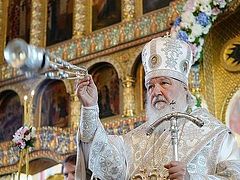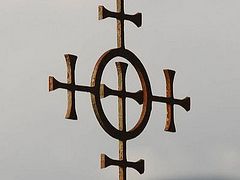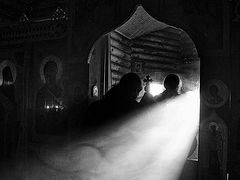A person who has had the great experience of communing with God, and has embarked on the path that we call spiritual life will certainly feel that the image of that spiritual life is determined first of all through a battle with oneself. The art of freeing ourselves from all that interferes with our communion with God is called asceticism, something that is most sharply manifested in monastic podvig, spiritual struggle.
Perhaps none of the truths of Orthodox instruction is subject to greater attack by the enemies of Christianity than is asceticism, monasticism in particular. Christianity’s enemies want to perceive within asceticism and monasticism some dark and evil principle, one that applies with distrust and hostility to everything related to a person’s physical life.
To utter such a reproach would be justifiable with respect to Buddhism, which perceives one’s body as some kind of prison of the soul, but as to Christianity, such reproach could come only from someone who has a poor understanding of the teachings of our Faith, or someone who is consciously intent upon slander.
No religious doctrine has a more exalted teaching regarding the human body than does Orthodox Christianity, which is the religion of Christ, Who became man, taking upon Himself the fullness of human nature, except for sin, of which He came to deliver us. The Apostle Paul says, that ye are the temple of God, and that the Spirit of God dwelleth in you (I Corinthians 3:16). The Church teaches that this temple, our flesh, which is in and of itself beautiful and perfect, fell, was stricken by sin, and is need of being cleansed in order that God’s plan for His creation might be revealed in its entirety.
No one would think to assert that in removing a malignant tumor, a surgeon is ruled by a feeling of hatred for the human body. The same applies with regard to Christian asceticism, which is the art with whose help the soul ceases to be enslaved by the body, and one’s body is joined to his immortality. The motive force of Christian asceticism is not in rejection of the body, or in religious selfishness, wherein one thinks only of how to rid himself from the power of sin; rather, it is in love.
The first Commandment is to love God, but it is inextricably linked to a second, “like unto it,” to love your neighbor as yourself. For that reason, Christian asceticism is not a vain self-mortification, but an affirmation of life in love, love of which only an enlightened heart is capable.
The Apostle John, the apostle of love, says to us: Love not the world, neither the things that are in the world. If any man love the world, the love of the Father is not in him (I John 2:15). Could this really be a call to dislike the world, God’s creation?
The overall spirit of St. John’s writings, and likewise that of the entire New Testament, rules out the possibility of such an interpretation. The
world towards which the Apostle John calls us to be hostile is not the world as created by God, but rather that spiritual sickness with which the world was struck, and from which [man] can, and is called to, rid it by the power of the Holy Spirit, which lives only in the Church of Christ, in all its Mysteries and especially in the Mystery of the Holy Eucharist. A person, especially an Orthodox Christian, cannot but love the world created by God, the world with which he is eternally tied in the act of Creation.
Through asceticism and monasticism, through that podvig, the person restores the image of God in himself and serves to heal the entire world, to return to the glory God had pronounced and with which He had crowned His Creation.
Used with permission.




